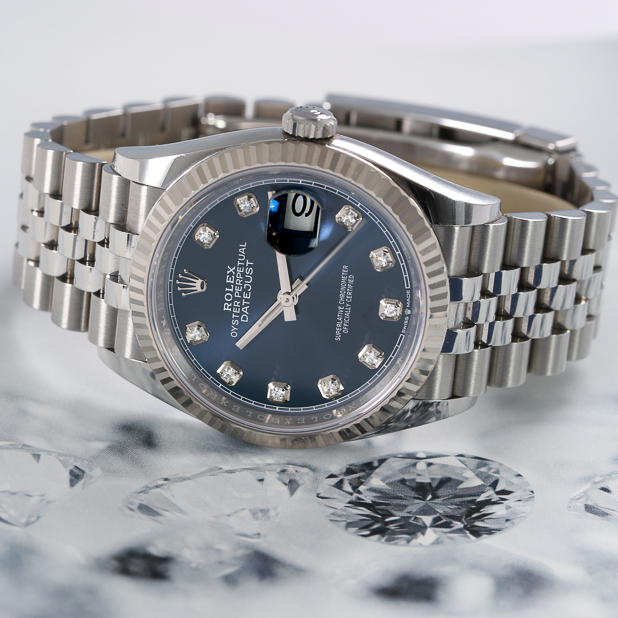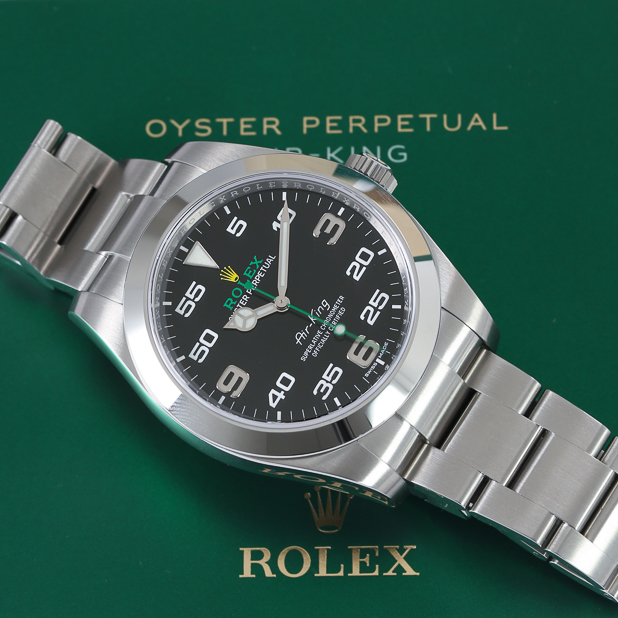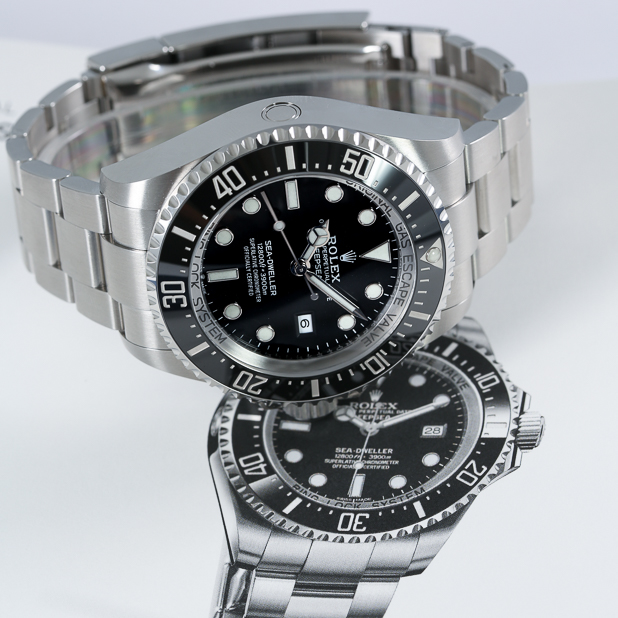Throughout Rolex history, the innovative approach of the company has brought us dust resistant, water resistant and even magnetic force resistant watches. And this is just a small sample of their achievements. The patents created by the company in their early days remain the cornerstones of watches made today, not only by Rolex, but all high-end watch making companies.
This blog will detail the unique and fascinating history behind one of the world’s most enthralling brands, Rolex. From the origins of the company to the modern day, we will discuss the company founder and his vision, as well as a few of the most iconic models ever produced under the Rolex name.
How Long has Rolex Been Around?
Exactly how long Rolex has been around is up for debate. The official, widely accepted line is that Rolex has been going since 1905 when Hans Wilsdorf founded a company in London specialising exclusively in the distribution of timepieces. However, if you were to ask this question to a Rolex aficionado, they could give you one of two additional answers.
Some believe the spirit of Rolex came to be two years prior to the official foundation of the business. In 1903, Wilsdorf left Germany for London to pursue his dream, so this can be seen as the true starting point.
Others would tie how long Rolex has been around to its name — the brand that has become so synonymous within the industry, and within the modern world. Upon initially founding his company, Wilsdorf would name it Wilsdorf & Davis (after himself and his brother-in-law Alfred Davis). But in 1908, the moniker of Rolex was adopted instead
To mark the 50 year anniversary of Rolex, Hans Wildorf would tell the world how the name came about. He said, “I tried combining the letters of the alphabet in every possible way. This gave me some hundred names, but none of them felt quite right. One morning, while riding on the upper deck of a horse-drawn omnibus along Cheapside in the City of London, a genie whispered ‘Rolex’ in my ear.”
Regardless of how long Rolex has been around, the purpose behind the brand’s origin has never been in question. Wristwatches were widely considered to be imprecise when the company first started, but few saw the form’s true potential quite like Hans Wilsdorf. He believed that equipping them with small and precise Swiss movements would do wonders to normalising wristwatches and making them more attractive.
How Rolex is Made
The process behind how each Rolex is made is a tale full of precision and master craftsmanship. Every piece of every watch produced by the company is assembled by hand. Machines only assist with the process — either entirely hand-operated or for handling more mundane activities (cataloguing, filing etc.).
Rolex doesn’t just make their watches by hand for the precision and the holistic appeal. Nowadays, every watch produced under the Rolex umbrella is made using a type of material found in no other watch, 904L steel, a material that is famously difficult to machine. Rolex began exclusively producing their timepieces using this material around the year 2003 due to multiple factors, including:
- Greater resistance to rust
- Greater corrosion resistance
- Harder than most other forms of steel
- Able to take polishes much better than other steels
Other than material costs, one of the bigger perceived drawbacks of 904L steel — and a key reason why it’s not commonly used in the industry — is that it is incredibly difficult to work with, and requires specialist tools and training.
Where is Rolex Made?
If you have your hands on a genuine Rolex, then every single piece of your watch has been produced and manufactured in one of the company’s four major locations in and around the Geneva area of Switzerland. The largest and most prevalent of these locations is in Les Acacias, the global headquarters for Rolex.
Part of what makes these watches so special boils down to exactly where your Rolex is made. Swiss watches are world renowned for their precision and craftsmanship. If you are looking at a Rolex watch that can be traced back to anywhere else in the world other than Switzerland, then you have a fake on your hands.
For more information on how to spot a fake Rolex, check out our blog going into further detail on the subject.
The First Ever Rolex
The origins of the first ever Rolex watch are contested. Many consider the first ever Rolex to be the Oyster, a waterproof and dustproof timepiece produced in 1926 in London. Others would argue that since Rolex founder Hans Wilsdorf created the 11-ligne Rebberg in 1910, that is technically the first ever Rolex.
The company themselves consider the Oyster to be the first. This model, while wildly different from the models today, does remain a popular part of the Rolex collection that is still being adapted and updated even now.
The reason many fans would hesitate to classify the 11-ligne Rebberg watch as truly the first ever Rolex comes down to the fact that all the pieces in the watch were manufactured by Aegler. Wilsford himself was never mentioned on the watch’s official documentation, making it hard to perceive as a Rolex.
Early Rolex Watches
The first sixty years of Rolex was full of innovations in both the production of new mechanisms and in the creation of a number of truly iconic timepieces. Many have stood the test of time and remain hugely popular to this day, including the Oyster Perpetual, the Datejust, and the Submariner.

Oyster
As mentioned, the watch widely believed to be the first ever Rolex is the Oyster, and it was a huge leap forward for the industry. The original featured a hermetically sealed case which would aid the protection of the movement from both water and dust.
The waterproof capabilities of the Rolex Oyster were ultimately proven in front of the eyes of a nation when a Rolex Oyster crossed the English Channel on the wrist of young English swimmer, Mercedes Gleitze in 1927. Despite the watch being in the water for around 10 hours, it worked perfectly when Gleitze came back on land.
Datejust
1945 saw the creation of another icon in Rolex history. The Datejust held the first self-winding watch chronometer ever produced to indicate the date in a window on the dial itself. The Datejust was equipped with a specially crafted Jubilee bracelet and a fluted bezel — a distinction that immediately marked the Datejust as a Rolex before you could even see the brand name.
Oyster Perpetual
The origins of the Oyster Perpetual can be traced as far back as 1931 when Rolex patented a self-winding watch movement. This stood out as one of the first movements of its kind to be wound via a rotor ‘weight’. This weight would allow the watch to constantly wind as the wearer moved their arm — hence the ‘Perpetual’ name.

The first official documentation to reference an Oyster Perpetual model came about in 1950. This model has truly stood the test of time and remains in production (albeit with a few modern updates) to this day.
Oyster Perpetual Explorer
An iconic watch created to celebrate one of the most iconic feats in human history. In 1953, Sir Edmund Hillary and Tenzing Norgay reached the summit of Mount Everest, the highest point on earth. Amongst their equipment was an Oyster Perpetual. Upon the scaling of Everest, Rolex released the Oyster Perpetual Explorer to mark the achievement. Thanks to its status as a footnote in history, this model quickly gained iconic status amongst the watch-loving world.
Submariner
Also launched in 1953, the Submariner was the first divers watch ever created that could withstand depths of up to 100 metres while sustaining its waterproofing. Additionally, the watch’s rotatable bezel would allow divers to read their immersion time while under the water.
Modern Rolex Watches
The catalogue of modern Rolex watches continues the past tradition of producing innovative and iconic timepieces. Some of the most popular and exemplary pieces produced in the modern era include the Daytona, the GMT Master II and Yacht Master models.
Daytona
First released back in 1963, the Daytona is the most famous of all racing watches and holds the distinction of perhaps being the single most sought after watch ever produced. This is true for both the classic models, as well as new ones released to the market. The cause for the clamour over this model can be traced back to the American actor and racer Paul Newman who would make the model a true cultural style touchpoint for the modern era.
Recent releases bearing the name ‘Cosmograph Daytona’ are modern interpretations of the classic. They retain much of what made the original such an icon, without feeling the need to alter too much beyond merely making a few minor updates.
The Rolex Daytona also holds the distinction of being the most expensive watch in the history of Rolex. The stainless steel Paul Newman Daytona would sell at auction in New York for $11.1 million, more than ten times over its estimate.
GMT Master II
The original GMT Master produced in 1954 represented the first, and to many, the most iconic dual timezone watch ever produced. It allowed the wearer to track two time zones at once.
However, its predecessor, the GMT Master II, released in 2007 was created to supersede the iconic original in just about every way, while modernising this classic watch.
This new generation of GMT allows you to set the 24 hour hand independently to track three time zones at once. The GMT Master II model is continuously updated with new releases as well as reissues, the most famous of which was the blue and red variant, nicknamed ‘Pepsi Cola’ after the famous drinks brand.
While it is near impossible to get your hands on these releases new, the second-hand market does provide you with some more flexibility.
Rolex Yacht-Master
A somewhat more niche model when compared to some of the others listed, the Rolex Yacht Master (and Yacht Master II) watches were created to pay homage to the close relationship Rolex has to the world of sailing, as well as the ocean itself.
Initially released back in 1992, the Yacht Master was released for the sailing community — a relatively small but very dedicated group.
The Greatest Rolex Innovations
From the famed Oyster case to the Milglaus and the Deep Sea watches, Rolex has made a name for itself as not just one of the most prestigious and beloved names in the watch industry, but one of the most innovative.
Perhaps the first ‘world changing’ innovation from Rolex came in 1926, with the patenting of the screw-down crown. This led to the creation of the Oyster case, so named because it made the case completely waterproof.

1931 saw Rolex patent an automatic rotary winding mechanism, meaning that the watch didn’t need to be hand wound, creating the first Oyster Perpetual.
As the ‘30s wore on, Rolex went through a series of ‘field tests’ to help them develop more innovative designs. These tests included the first ever flight over Everest in 1933, with the pilots commending the accuracy of the watch, as well as land speed record setting runs on the wrist of Sir Malcolm Campbell.
Three more significant innovations were introduced by Rolex in the ‘40s and ‘50s. In 1945, Rolex released the iconic Oyster Perpetual Datejust. The Datejust was the first waterproof automatic chronometer to feature a date visible through a window in the dial. It became an instant success and is still the linchpin of the Rolex Oyster collection to this day.
By the mid 1950s Rolex had developed two new watches, with the intention of enabling further scientific research in areas where watches had been unable to previously go. In September 1953 a specially adapted Rolex watch, known as a Deep Sea, found itself still working after a plunge to over 10,000 feet on Auguste Piccard’s ‘Trieste’. Seven years later, a new version of the watch emerged intact from a depth of 35,000 feet as the ‘Trieste’ explored the Mariana ocean trench.
Rolex also turned their attention to the effect of magnetic fields upon watch movements. In 1956 Rolex introduced The Milgauss, a watch that was highly resistant to magnetic force. The name ‘Milgauss’ comes from the French word ‘Mille’, meaning one thousand, and Gauss which is a measurement of magnetic force.
As the name suggests, the Milgauss is guaranteed to resist a force of 1000 Gauss, but the watch was tested and found to work perfectly well at a level of magnetic field five times higher. The Milgauss was confirmed to work past its guaranteed maximum limit whilst in use at The European Organisation for Nuclear Research (CERN) in Geneva.
The Hans Wilsdorf Foundation
In accordance with the will of Hans Wilsford, Rolex is believed to be the only private company in the entire world that donates its profits to the benefit of society at large. This is done via the famed Hans Wilsdorf foundation.
Despite all the great innovations Rolex has had a hand in, and all of the iconic people that have worn and adored the brands timepieces, could this non-profit business model be their greatest achievement?
When his wife died in 1944 Hans Wilsdorf, founder of Rolex, established the Foundation. He donated all his shares in the company with the proviso that part of the company’s income would go to various charitable causes. The trust has owned and run the company since Wilsdorf’s death in 1966 and the principles set down by him are still followed to this day.
Rolex remains a private company. Its financial records are not made public, so it is difficult to know exactly how much of the income actually finds its way to Charitable causes.
Hans Wilsdorf was an orphan and it is thought that some of the funds available to the trust go to various children’s charities around the world.
On top of the charitable side, the trust also oversees the day-to-day running of the company and a good portion of the profit is reinvested into the company. This allowed Rolex to continue to innovate long after the death of its founder.
The Hans Wilsdorf Foundation works in the fields of social action, training and culture across various territories around Geneva — contributing to the education, social services, employment, culture, and more in the area.
Why Deal With Blowers Jewellers When Buying Your Dream Rolex Watch
Rolex history is full of innovation, excellence, and feats that will never be forgotten. Thanks to over 50 years of experience working in the second-hand luxury watch and jewellery markets, we are perfectly placed to help pair you with the Rolex of your dreams.
Whether you are a first time buyer or an experienced collector, we can help. Our knowledge of the second-hand Rolex market is unmatched. We know the importance of getting that dream Rolex can have. This is why we always strive to ensure that our service is as personal and efficient as possible, for you.
For further information on what the team at Blowers Jewellers can do to assist you in finding the perfect vintage Rolex watch for you, or if you would like a guide through our stunning collection of pre-owned luxury watches and jewellery, please contact a member of our team today.
